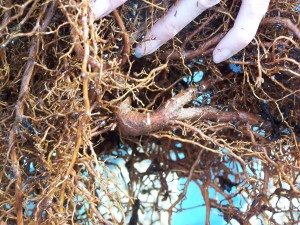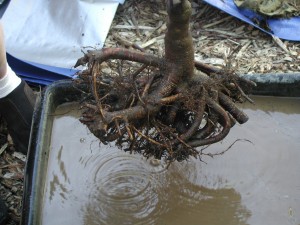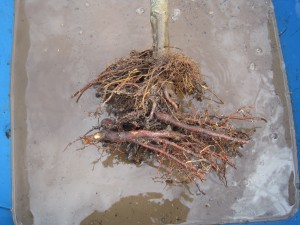One of the great things about doing a multi-author science blog is that there will be topics about which colleagues will disagree. One of those topics revolves around the best way to prepare woody rooted plants (trees and shrubs) before planting them. This is an area in arboricultural science that is evolving. A search through our blog archives will find many of these posts and for convenience’s sake I’ve linked one from each of us here.
From Jeff (2009)
From Bert (2014)
From Linda (2013)
Rather than belabor the points that Jeff, Bert and I have already made in our posts, I think I can sum up our major difference here: I like to bare-root trees and shrubs completely before planting (so I can correctively prune all flawed roots) while Bert and Jeff prefer a less invasive approach. What we do agree upon, however, is the deplorable condition of the roots of many trees and shrubs that end up in the nursery. Because I do practice bare-rooting trees, I thought I’d use today’s post as a rogue’s gallery of trees that should never have made it to the retail nursery. (All of these trees were ones that I bare-rooted and root-pruned myself before planting – and all are thriving.)




This is an ongoing horror in the industry. I work in a retail garden center and we tell our customers to plant a few inched above grade. But what I am finding across the nurseries we use are trees that are buried, both in containers and b&b. Field grown trees that are mechanically dug have excess soil pushed up over the root ball and trapped by the burlap. Container trees that have been bumped up are just planted way too deep. Flaws from poor planting when samplings are planted are never corrected. Yes the trees live for years with no problems. Then years down the road the homeowner has a failing tree and we in the retail business are looking at an angry customer who has to remove an established tree.
You’ve nailed it on the head Andrea! I wish more people in the industry would acknowledge this problem with plant production rather than putting their heads in the sand (or soilless media).
If only I had read these, and related, articles a few weeks sooner. I planted 40, 5′ tall burr oaks and sugar maples this fall that were ‘oversized’ bare-root from the local tree nursery. They were field grown and then put into pots when they got too big so I got them ‘cheap’. The oaks especially had serious root spirals. I knew this was an issue but wasnt confident about pruning large circling roots. Dig them up in the spring and replant?
You don’t want to do this in the spring. Your trees will be breaking dormancy and sending resources to the crown. Best to do it now, but if not possible wait until next fall. It sounds like you will need to remove a significant amount of roots and that’s the best chance you have for survival.